

Compact Muon Solenoid
LHC, CERN
| CMS-B2G-21-007 ; CERN-EP-2022-253 | ||
| Search for a vector-like quark T' $ \to$ tH via the diphoton decay mode of the Higgs boson in proton-proton collisions at $ \sqrt{s}= $ 13 TeV | ||
| CMS Collaboration | ||
| 24 February 2023 | ||
| JHEP 09 (2023) 057 | ||
| Abstract: A search for the electroweak production of a vector-like quark T' decaying to a top quark and a Higgs boson is presented. The search is based on a sample of proton-proton collision events recorded at the LHC at $ \sqrt{s}= $ 13 TeV, corresponding to an integrated luminosity of 138 fb$ ^{-1} $. This is the first T' search that exploits the Higgs boson decay to a pair of photons. For narrow isospin singlet T' states with masses up to 1.1 TeV, the excellent diphoton invariant mass resolution of 1-2% results in an increased sensitivity compared to previous searches based on the same production mechanism. The electroweak production of a T' quark with mass up to 960 GeV is excluded at 95% confidence level, assuming a coupling strength $ \kappa_{\mathrm{T}} = $ 0.25 and a relative decay width $ \Gamma/M_{\mathrm{T}'} < $ 5%. | ||
| Links: e-print arXiv:2302.12802 [hep-ex] (PDF) ; CDS record ; inSPIRE record ; HepData record ; Physics Briefing ; CADI line (restricted) ; | ||
| Figures | |
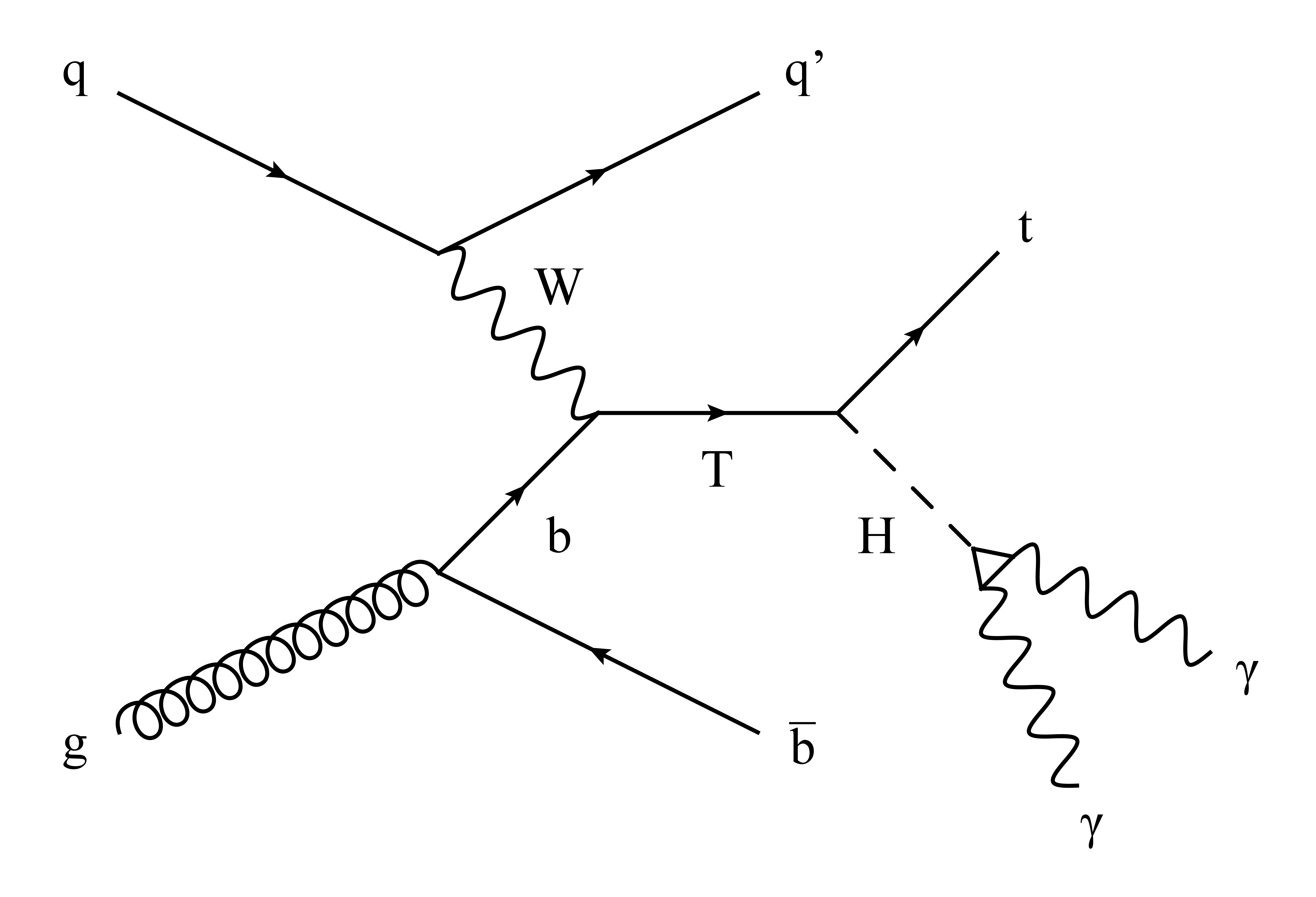
png pdf |
Figure 1:
Leading-order Feynman diagram for single T' production in Wb fusion and its subsequent decay into tH ($ \mathrm{H} \to \gamma\gamma $) |
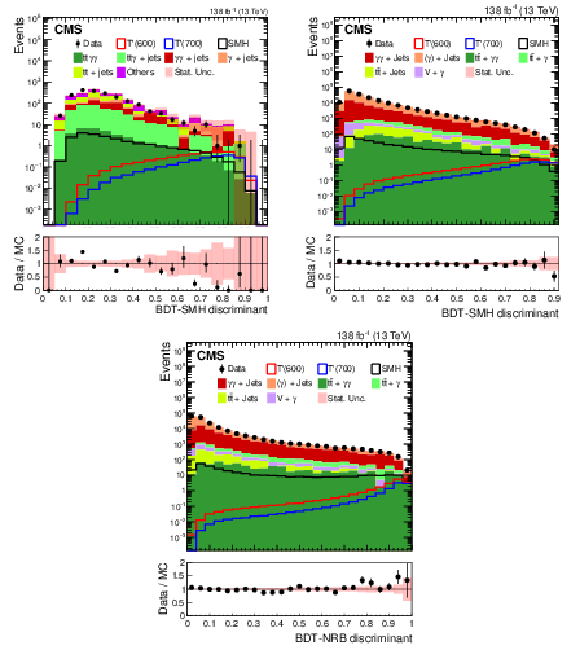
png pdf |
Figure 2:
The BDT output distributions for data, backgrounds and signal events in the leptonic and the hadronic categories: leptonic BDT trained against the SM Higgs boson backgrounds (upper left), hadronic BDT trained against the SM Higgs boson backgrounds (upper right), and hadronic BDT trained against the nonresonant backgrounds processes (lower). For the leptonic category, MC-estimated nonresonant backgrounds are normalized to the number of observed data events. For the hadronic category, a data-driven estimation has been adapted for $ \gamma$+jets backgrounds, while all other MC samples are normalized to an integrated luminosity of 138 fb$ ^{-1} $. |
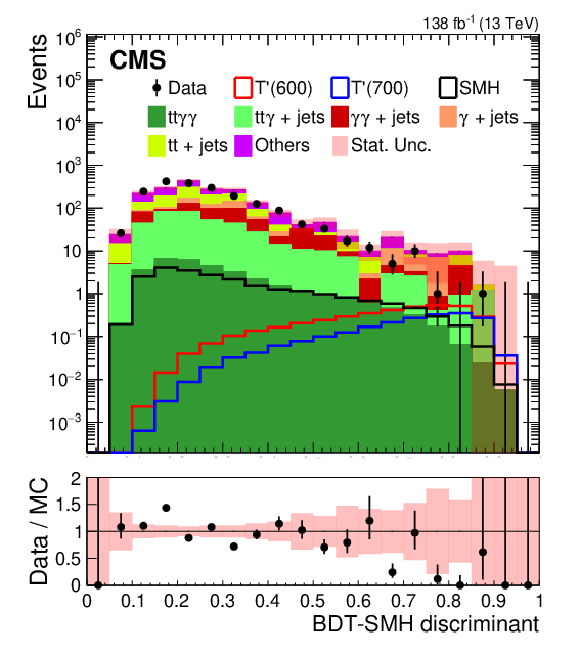
png pdf |
Figure 2-a:
The BDT output distributions for data, backgrounds and signal events in the leptonic and the hadronic categories: leptonic BDT trained against the SM Higgs boson backgrounds (upper left), hadronic BDT trained against the SM Higgs boson backgrounds (upper right), and hadronic BDT trained against the nonresonant backgrounds processes (lower). For the leptonic category, MC-estimated nonresonant backgrounds are normalized to the number of observed data events. For the hadronic category, a data-driven estimation has been adapted for $ \gamma$+jets backgrounds, while all other MC samples are normalized to an integrated luminosity of 138 fb$ ^{-1} $. |
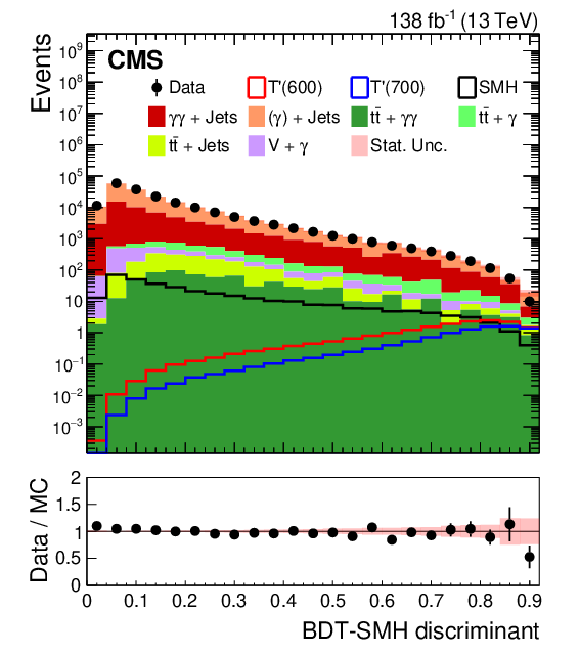
png pdf |
Figure 2-b:
The BDT output distributions for data, backgrounds and signal events in the leptonic and the hadronic categories: leptonic BDT trained against the SM Higgs boson backgrounds (upper left), hadronic BDT trained against the SM Higgs boson backgrounds (upper right), and hadronic BDT trained against the nonresonant backgrounds processes (lower). For the leptonic category, MC-estimated nonresonant backgrounds are normalized to the number of observed data events. For the hadronic category, a data-driven estimation has been adapted for $ \gamma$+jets backgrounds, while all other MC samples are normalized to an integrated luminosity of 138 fb$ ^{-1} $. |
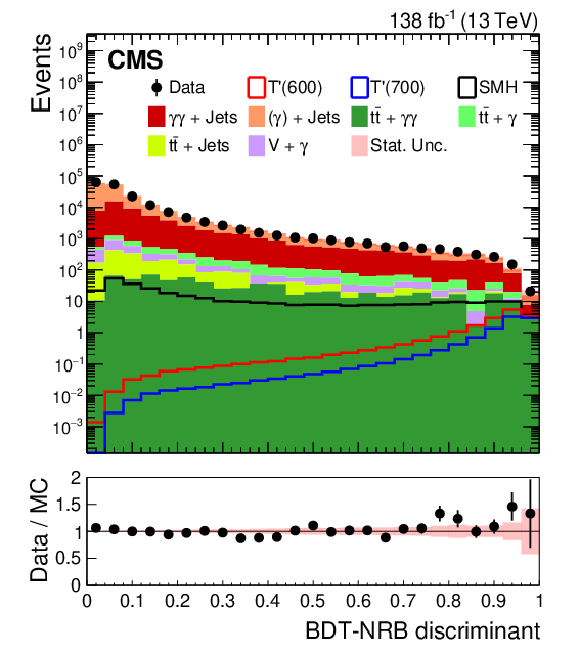
png pdf |
Figure 2-c:
The BDT output distributions for data, backgrounds and signal events in the leptonic and the hadronic categories: leptonic BDT trained against the SM Higgs boson backgrounds (upper left), hadronic BDT trained against the SM Higgs boson backgrounds (upper right), and hadronic BDT trained against the nonresonant backgrounds processes (lower). For the leptonic category, MC-estimated nonresonant backgrounds are normalized to the number of observed data events. For the hadronic category, a data-driven estimation has been adapted for $ \gamma$+jets backgrounds, while all other MC samples are normalized to an integrated luminosity of 138 fb$ ^{-1} $. |
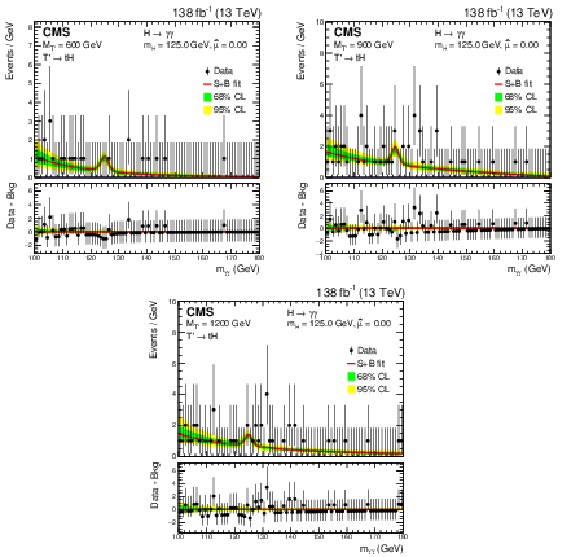
png pdf |
Figure 3:
The combined, leptonic plus hadronic, distributions for data (black dots) and $ m_{\gamma\gamma} $ signal-plus-background model fits (red line) for a VLQ signal with $ M_{\mathrm{T}'} $ of 600 (upper left), 900 (upper right), and 1200 GeV (lower). The green (yellow) band represents the 68% (95%) CL in the background component of the fit. The peak in the background component shows the considered irreducible SM Higgs boson (ggH, VBF, VH, $ {\mathrm{t}\bar{\mathrm{t}}} \mathrm{H} $ and tH) contribution. Here, $ \hat{\mu} $ is the best fit value of the signal strength parameter $ \mu $, which is zero for the two $ M_{\mathrm{T}'} $ values considered. The lower panel shows the residuals after the subtraction of the background component. |
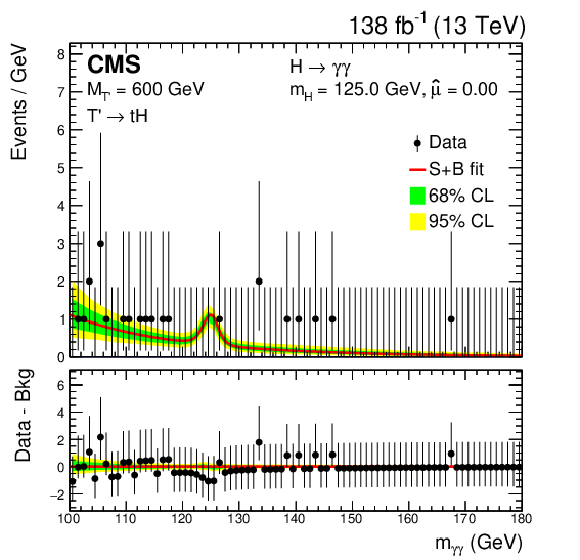
png pdf |
Figure 3-a:
The combined, leptonic plus hadronic, distributions for data (black dots) and $ m_{\gamma\gamma} $ signal-plus-background model fits (red line) for a VLQ signal with $ M_{\mathrm{T}'} $ of 600 (upper left), 900 (upper right), and 1200 GeV (lower). The green (yellow) band represents the 68% (95%) CL in the background component of the fit. The peak in the background component shows the considered irreducible SM Higgs boson (ggH, VBF, VH, $ {\mathrm{t}\bar{\mathrm{t}}} \mathrm{H} $ and tH) contribution. Here, $ \hat{\mu} $ is the best fit value of the signal strength parameter $ \mu $, which is zero for the two $ M_{\mathrm{T}'} $ values considered. The lower panel shows the residuals after the subtraction of the background component. |
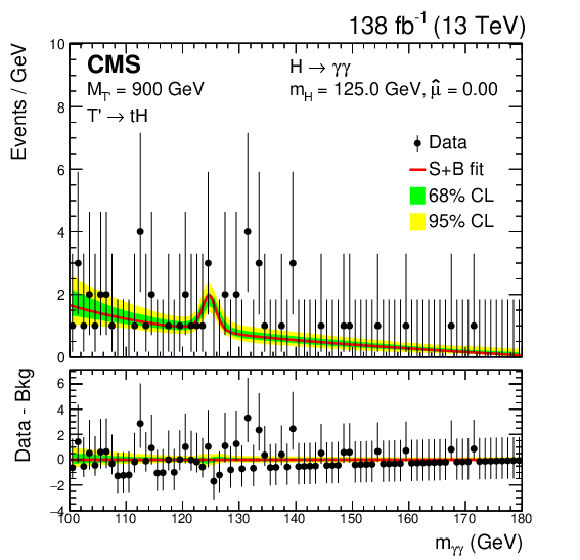
png pdf |
Figure 3-b:
The combined, leptonic plus hadronic, distributions for data (black dots) and $ m_{\gamma\gamma} $ signal-plus-background model fits (red line) for a VLQ signal with $ M_{\mathrm{T}'} $ of 600 (upper left), 900 (upper right), and 1200 GeV (lower). The green (yellow) band represents the 68% (95%) CL in the background component of the fit. The peak in the background component shows the considered irreducible SM Higgs boson (ggH, VBF, VH, $ {\mathrm{t}\bar{\mathrm{t}}} \mathrm{H} $ and tH) contribution. Here, $ \hat{\mu} $ is the best fit value of the signal strength parameter $ \mu $, which is zero for the two $ M_{\mathrm{T}'} $ values considered. The lower panel shows the residuals after the subtraction of the background component. |

png pdf |
Figure 3-c:
The combined, leptonic plus hadronic, distributions for data (black dots) and $ m_{\gamma\gamma} $ signal-plus-background model fits (red line) for a VLQ signal with $ M_{\mathrm{T}'} $ of 600 (upper left), 900 (upper right), and 1200 GeV (lower). The green (yellow) band represents the 68% (95%) CL in the background component of the fit. The peak in the background component shows the considered irreducible SM Higgs boson (ggH, VBF, VH, $ {\mathrm{t}\bar{\mathrm{t}}} \mathrm{H} $ and tH) contribution. Here, $ \hat{\mu} $ is the best fit value of the signal strength parameter $ \mu $, which is zero for the two $ M_{\mathrm{T}'} $ values considered. The lower panel shows the residuals after the subtraction of the background component. |
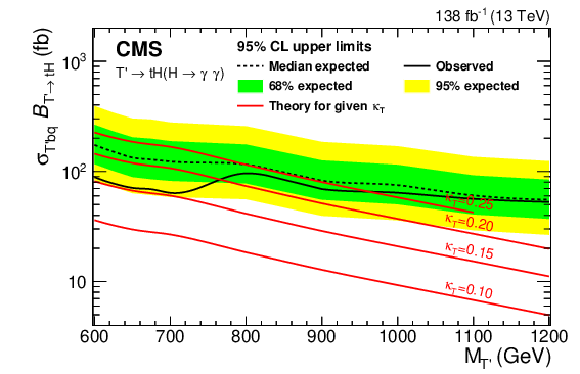
png pdf |
Figure 4:
The combined, leptonic plus hadronic, expected (dotted black) and observed (solid black) upper limits at 95% CL on $ \sigma_{\mathrm{T}'\mathrm{b}\mathrm{q}}\mathcal{B_{\mathrm{T}'\to \mathrm{t}\mathrm{H}}} $ are displayed as a function of $ M_{\mathrm{T}'} $. The green (yellow) band represents the 68% (95%) of the limit values expected under the background-only hypothesis. The theoretical cross sections for the singlet T' production with representative $ \kappa_{\mathrm{T}} $-values fixed at 0.1, 0.15, 0.2 and 0.25 (for $ \Gamma/M_{\mathrm{T}'} < $ 5%) are shown as red lines. |
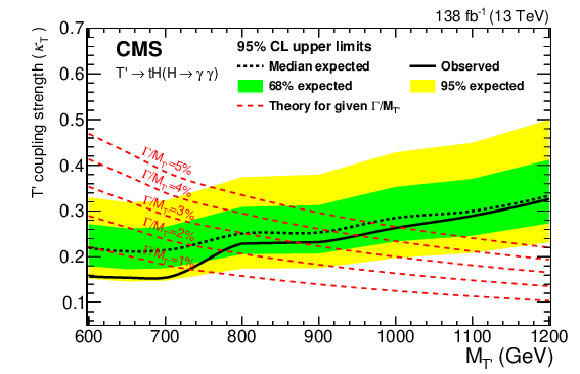
png pdf |
Figure 5:
The combined, leptonic plus hadronic, expected (dotted black) and observed (solid black) upper limits at 95% CL on the T' coupling to third-generation quarks, $ \kappa_{\mathrm{T}} $, under the narrow width approximation displayed as a function of $ M_{\mathrm{T}'} $. The green (yellow) band represents the 68% (95%) of the limit values expected under the background-only hypothesis. The theoretical $ \kappa_{\mathrm{T}} $ values corresponding to the $ \Gamma/M_{\mathrm{T}'} $-values fixed at 1, 2, 3, 4, and 5% are shown as red dashed lines. |
| Tables | |
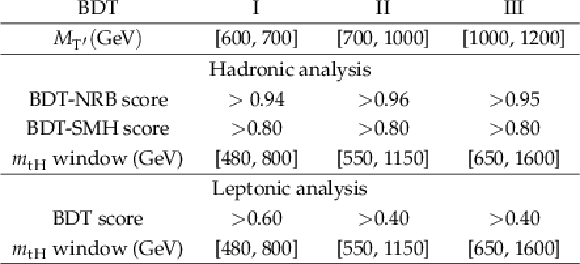
png pdf |
Table 1:
Signal selection criteria for the three BDTs and $ m_{\mathrm{t}\mathrm{H}} $ windows. |
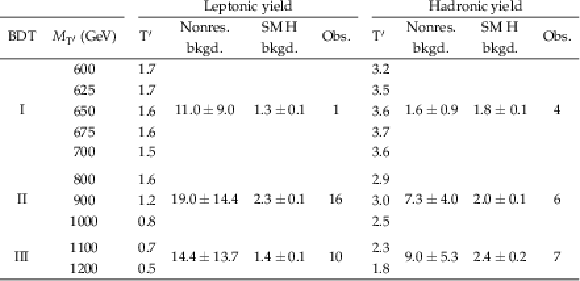
png pdf |
Table 2:
The expected yields of different processes in each signal window for events with a T' with mass in the range $ M_{\mathrm{T}'}\in $ [600, 1200] GeV, and the observed number of events in the signal region $ m_{\gamma\gamma} \in $ [115, 135]. Here, the yields for the T' are for $ \kappa_{\mathrm{T}} $ fixed at 0.2. |
| Summary |
| A search for a vector-like quark decaying to a top quark and a Higgs boson that decays into two photons, T' $ \to$ tH (H $ \to \gamma\gamma $), has been performed using proton-proton collision data at $ \sqrt{s} = $ 13 TeV recorded with the CMS detector in 2016-2018, and corresponding to an integrated luminosity of 138 fb$ ^{-1} $. The search has been carried out based on a model of T' electroweak production in a narrow width approximation with a ratio of T' width relative to its mass ($ \Gamma/M_{\mathrm{T}'} $) $ \approx 1% $. The sensitivity of this analysis extends up to $ \Gamma/M_{\mathrm{T}'}\approx 5% $, which roughly corresponds to the experimental resolution of $ M_{\mathrm{T}'} $. Both the hadronic and leptonic decay modes of the top quark are considered in the search. A novel multivariate analysis incorporating three separately optimized boosted decision trees is exploited to separate likely signal events from background processes, including the standard model production of Higgs bosons. No statistically significant excess over the expected background prediction is observed. Assuming a coupling to third generation quarks of $ \kappa_{\mathrm{T}} = $ 0.25 and a relative decay width of $ \Gamma/M_{\mathrm{T}'} < 5% $, the electroweak production of a singlet T' quark is excluded up to a mass of 960 GeV at 95% confidence level. This search for a vector-like quark, T' is the most sensitive to date for $ M_{\mathrm{T}'} $ up to 1.1 TeV, among searches exploring the same production mechanism. |
| References | ||||
| 1 | ATLAS Collaboration | Observation of a new particle in the search for the standard model Higgs boson with the ATLAS detector at the LHC | PLB 716 (2012) 1 | 1207.7214 |
| 2 | CMS Collaboration | Observation of a new boson at a mass of 125 GeV with the CMS experiment at the LHC | PLB 716 (2012) 30 | CMS-HIG-12-028 1207.7235 |
| 3 | CMS Collaboration | Observation of a new boson with mass near 125 GeV in pp collisions at $ \sqrt{s} = $ 7 and 8 TeV | JHEP 06 (2013) 81 | CMS-HIG-12-036 1303.4571 |
| 4 | L. Susskind | Dynamics of spontaneous symmetry breaking in the Weinberg--Salam theory | PRD 20 (1979) 2619 | |
| 5 | R. Contino, L. Da Rold, and A. Pomarol | Light custodians in natural composite Higgs models | PRD 75 (2007) 055014 | hep-ph/0612048 |
| 6 | R. Contino, T. Kramer, M. Son, and R. Sundrum | Warped/composite phenomenology simplified | JHEP 07 (2007) 074 | hep-ph/0612180 |
| 7 | D. B. Kaplan | Flavor at SSC energies: A new mechanism for dynamically generated fermion masses | NPB 365 (1991) 259 | |
| 8 | M. J. Dugan, H. Georgi, and D. B. Kaplan | Anatomy of a composite Higgs model | NPB 254 (1985) 299 | |
| 9 | S. Blasi and F. Goertz | Softened symmetry breaking in composite Higgs models | PRL 123 (2019) 221801 | 1903.06146 |
| 10 | M. Perelstein, M. E. Peskin, and A. Pierce | Top quarks and electroweak symmetry breaking in little Higgs models | PRD 69 (2004) 075002 | hep-ph/0310039 |
| 11 | O. Matsedonskyi, G. Panico, and A. Wulzer | Light top partners for a light composite Higgs | JHEP 01 (2013) 164 | 1204.6333 |
| 12 | M. Schmaltz and D. Tucker-Smith | Little Higgs review | Annu. Rev. Nucl. Part. Sci. 55 (2005) 229 | hep-ph/0502182 |
| 13 | L. Randall and R. Sundrum | A large mass hierarchy from a small extra dimension | PRL 83 (1999) 3370 | hep-ph/9905221 |
| 14 | J. A. Aguilar-Saavedra, R. Benbrik, S. Heinemeyer, and M. P é rez-Victoria | Handbook of vectorlike quarks: Mixing and single production | PRD 88 (2013) 094010 | 1306.0572 |
| 15 | A. Deandrea et al. | Single production of vector-like quarks: the effects of large width, interference and NLO corrections | JHEP 08 (2021) 107 | 2105.08745 |
| 16 | A. Roy, N. Nikiforou, N. Castro, and T. Andeen | Novel interpretation strategy for searches of singly produced vectorlike quarks at the LHC | PRD 101 (2020) 115027 | 2003.00640 |
| 17 | S. Banerjee et al. | Phenomenological analysis of multi-pseudoscalar mediated dark matter models | JHEP 07 (2022) 111 | 2110.15391 |
| 18 | ATLAS Collaboration | Combination of the searches for pair-produced vector-like partners of the third-generation quarks at $ \sqrt{s} = $ 13 TeV with the ATLAS detector | PRL 121 (2018) 211801 | 1808.02343 |
| 19 | CMS Collaboration | Search for pair production of vector-like quarks in the fully hadronic final state | PRD 100 (2019) 072001 | 1906.11903 |
| 20 | CMS Collaboration | Search for electroweak production of a vector-like T quark using fully hadronic final states | JHEP 01 (2020) 36 | 1909.04721 |
| 21 | ATLAS Collaboration | Search for single production of a vector-like $ {\HepParticle{T}} $ quark decaying into a Higgs boson and top quark with fully hadronic final states using the ATLAS detector | PRD 105 (2022) 092012 | 2201.07045 |
| 22 | CMS Collaboration | Search for pair production of vector-like quarks in leptonic final states in proton-proton collisions at $ \sqrt{s} = $ 13 TeV | Submitted to JHEP, 2022 | 2209.07327 |
| 23 | ATLAS Collaboration | Search for pair-produced vector-like top and bottom partners in events with large missing transverse momentum in pp collisions with the ATLAS detector | Submitted to \emphEur. Phy. J. C, 2022 | 2212.05263 |
| 24 | CMS Collaboration | Measurements of Higgs boson production cross sections and couplings in the diphoton decay channel at $ \sqrt{s} = $ 13 TeV | JHEP 07 (2021) 027 | CMS-HIG-19-015 2103.06956 |
| 25 | CMS Collaboration | The CMS experiment at the CERN LHC | JINST 3 (2008) S08004 | |
| 26 | CMS Collaboration | Performance of the CMS Level-1 trigger in proton-proton collisions at $ \sqrt{s} = $ 13 TeV | JINST 15 (2020) P10017 | CMS-TRG-17-001 2006.10165 |
| 27 | CMS Collaboration | The CMS trigger system | JINST 12 (2017) P01020 | CMS-TRG-12-001 1609.02366 |
| 28 | CMS Collaboration | Electron and photon reconstruction and identification with the CMS experiment at the CERN LHC | JINST 16 (2021) P05014 | CMS-EGM-17-001 2012.06888 |
| 29 | CMS Collaboration | Performance of the CMS muon detector and muon reconstruction with proton-proton collisions at $ \sqrt{s} = $ 13 TeV | JINST 13 (2018) P06015 | CMS-MUO-16-001 1804.04528 |
| 30 | CMS Collaboration | Description and performance of track and primary-vertex reconstruction with the CMS tracker | JINST 9 (2014) P10009 | CMS-TRK-11-001 1405.6569 |
| 31 | CMS Collaboration | Particle-flow reconstruction and global event description with the CMS detector | JINST 12 (2017) P10003 | CMS-PRF-14-001 1706.04965 |
| 32 | CMS Collaboration | Technical proposal for the Phase-II upgrade of the Compact Muon Solenoid | CMS Technical Proposal CERN-LHCC-2015-010, CMS-TDR-15-02, 2015 CDS |
|
| 33 | CMS Collaboration | CMS technical design report for the pixel detector upgrade | cms technical design report, 2012 link |
|
| 34 | CMS Collaboration | Performance of b tagging algorithms in proton-proton collisions at 13 TeV with Phase 1 CMS detector | CMS Detector Performance Report CMS-DP-2018-033, 2018 CDS |
|
| 35 | GEANT4 Collaboration | GEANT 4---a simulation toolkit | NIM A 506 (2003) 250 | |
| 36 | J. Alwall et al. | The automated computation of tree-level and next-to-leading order differential cross sections, and their matching to parton shower simulations | JHEP 07 (2014) 079 | 1405.0301 |
| 37 | P. Artoisenet, R. Frederix, O. Mattelaer, and R. Rietkerk | Automatic spin-entangled decays of heavy resonances in Monte Carlo simulations | JHEP 03 (2013) 015 | 1212.3460 |
| 38 | NNPDF Collaboration | Parton distributions from high-precision collider data | EPJC 77 (2017) 663 | 1706.00428 |
| 39 | E. Bagnaschi, G. Degrassi, P. Slavich, and A. Vicini | Higgs production via gluon fusion in the POWHEG approach in the SM and in the MSSM | JHEP 02 (2012) 088 | 1111.2854 |
| 40 | P. Nason and C. Oleari | NLO Higgs boson production via vector-boson fusion matched with shower in POWHEG | JHEP 02 (2010) 037 | 0911.5299 |
| 41 | H. B. Hartanto, B. Jager, L. Reina, and D. Wackeroth | Higgs boson production in association with top quarks in the POWHEG BOX | PRD 91 (2015) 094003 | 1501.04498 |
| 42 | G. Luisoni, P. Nason, C. Oleari, and F. Tramontano | $ \mathrm{H}\mathrm{W}^{\pm} $/HZ + 0 and 1 jet at NLO with the POWHEG BOX interfaced to GoSam and their merging within MiNLO | JHEP 10 (2013) 083 | 1306.2542 |
| 43 | LHC Higgs Cross Section Working Group | Handbook of LHC Higgs Cross Sections: 4. Deciphering the nature of the Higgs sector | CERN Yellow Rep. Monogr. 2 (2017) | 1610.07922 |
| 44 | T. Sjöstrand et al. | An introduction to PYTHIA8.2 | Comput. Phys. Commun. 191 (2015) 159 | 1410.3012 |
| 45 | Sherpa Collaboration | Event generation with SHERPA 2.2 | SciPost Phys. 7 (2019) 034 | 1905.09127 |
| 46 | CMS Collaboration | Event generator tunes obtained from underlying event and multiparton scattering measurements | EPJC 76 (2016) 155 | CMS-GEN-14-001 1512.00815 |
| 47 | CMS Collaboration | Extraction and validation of a new set of CMS PYTHIA8 tunes from underlying-event measurements | EPJC 80 (2020) 4 | CMS-GEN-17-001 1903.12179 |
| 48 | M. Cacciari, G. P. Salam, and G. Soyez | The anti-$ k_{\mathrm{T}} $ jet clustering algorithm | JHEP 04 (2008) 063 | 0802.1189 |
| 49 | M. Cacciari, G. P. Salam, and G. Soyez | FastJet user manual | EPJC 72 (2012) 1896 | 1111.6097 |
| 50 | CMS Collaboration | Performance of reconstruction and identification of $ \tau $ leptons decaying to hadrons and $ \nu_{\!\tau} $ in pp collisions at $ \sqrt{s}= $ 13 TeV | JINST 13 (2018) P10005 | CMS-TAU-16-003 1809.02816 |
| 51 | CMS Collaboration | Jet energy scale and resolution in the CMS experiment in pp collisions at 8 TeV | JINST 12 (2017) P02014 | CMS-JME-13-004 1607.03663 |
| 52 | CMS Collaboration | Performance of missing transverse momentum reconstruction in proton-proton collisions at $ \sqrt{s} = $ 13 TeV using the CMS detector | JINST 14 (2019) P07004 | CMS-JME-17-001 1903.06078 |
| 53 | CMS Collaboration | Determination of jet energy calibration and transverse momentum resolution in CMS | JINST 6 (2011) P11002 | CMS-JME-10-011 1107.4277 |
| 54 | CMS Collaboration | Identification of heavy-flavour jets with the CMS detector in pp collisions at 13 TeV | JINST 13 (2018) P05011 | CMS-BTV-16-002 1712.07158 |
| 55 | CMS Collaboration | Measurements of $ \mathrm{t\bar{t}}H $ production and the CP structure of the Yukawa interaction between the Higgs boson and top quark in the diphoton decay channel | PRL 125 (2020) 061801 | CMS-HIG-19-013 2003.10866 |
| 56 | CMS Collaboration | Search for flavor-changing neutral current interactions of the top quark and Higgs boson in final states with two photons in proton-proton collisions at $ \sqrt{s}= $ 13 TeV | PRL 129 (2022) 032001 | CMS-TOP-20-007 2111.02219 |
| 57 | H. Voss, A. Höcker, J. Stelzer, and F. Tegenfeldt | TMVA, the toolkit for multivariate data analysis with ROOT | in XIth International Workshop on Advanced Computing and Analysis Techniques in Physics Research (ACAT), 2007 link |
physics/0703039 |
| 58 | CMS Collaboration | Evidence for the associated production of a single top quark and a photon in proton-proton collisions at $ \sqrt{s}= $ 13 TeV | no.~22, 221802, 2018 PRL 121 (2018) |
CMS-TOP-17-016 1808.02913 |
| 59 | CMS Collaboration | Search for the flavor-changing neutral current interactions of the top quark and the Higgs boson which decays into a pair of b quarks at $ \sqrt{s}= $ 13 TeV | JHEP 06 (2018) 102 | CMS-TOP-17-003 1712.02399 |
| 60 | P. D. Dauncey, M. Kenzie, N. Wardle, and G. J. Davies | Handling uncertainties in background shapes: the discrete profiling method | JINST 10 (2015) P04015 | 1408.6865 |
| 61 | R. Fisher | On the interpretation of $ \chi^2 $ from contingency tables, and the calculation of p | J. R. Stat. Soc 85 (1922) 87 | |
| 62 | CMS Collaboration | Precision luminosity measurement in proton-proton collisions at $ \sqrt{s} = $ 13 TeV in 2015 and 2016 at CMS | EPJC 81 (2021) 800 | CMS-LUM-17-003 2104.01927 |
| 63 | CMS Collaboration | CMS luminosity measurement for the 2017 data-taking period at $ \sqrt{s} = $ 13 TeV | CMS Physics Analysis Summary, 2018 link |
CMS-PAS-LUM-17-004 |
| 64 | CMS Collaboration | CMS luminosity measurement for the 2018 data-taking period at $ \sqrt{s} = $ 13 TeV | CMS Physics Analysis Summary, 2019 link |
CMS-PAS-LUM-18-002 |
| 65 | T. Junk | Confidence level computation for combining searches with small statistics | NIM A 434 (1999) 435 | hep-ex/9902006 |
| 66 | A. L. Read | Presentation of search results: the $ \text{CL}_\text{s} $ technique | JPG 28 (2002) 2693 | |
| 67 | G. Cowan, K. Cranmer, E. Gross, and O. Vitells | Asymptotic formulae for likelihood-based tests of new physics | EPJC 71 (2011) 1554 | 1007.1727 |
| 68 | G. J. Feldman and R. D. Cousins | A unified approach to the classical statistical analysis of small signals | PRD 57 (1998) 3873 | physics/9711021 |
| 69 | CMS Collaboration | HEPData record for this analysis | link | |

|
Compact Muon Solenoid LHC, CERN |

|

|

|

|

|

|